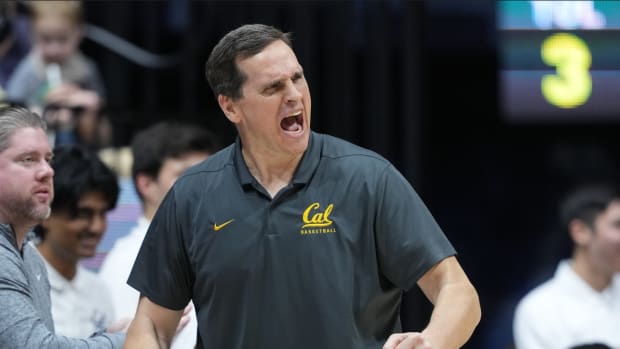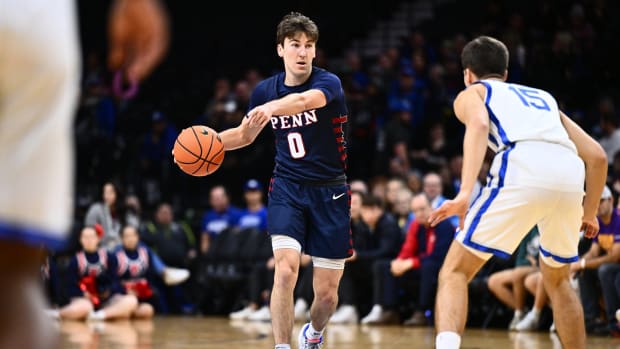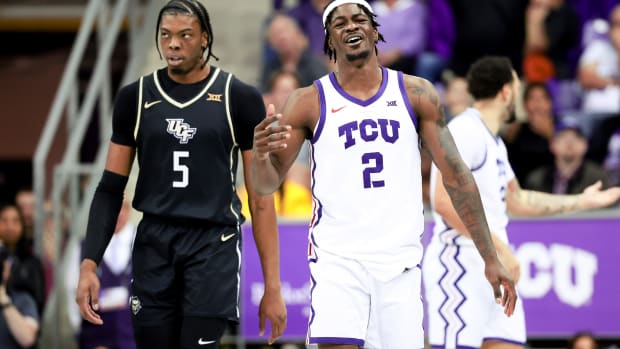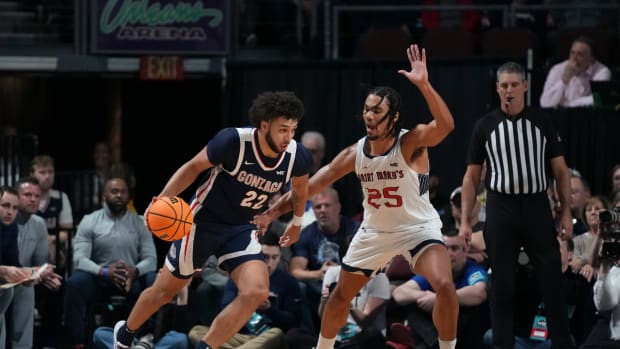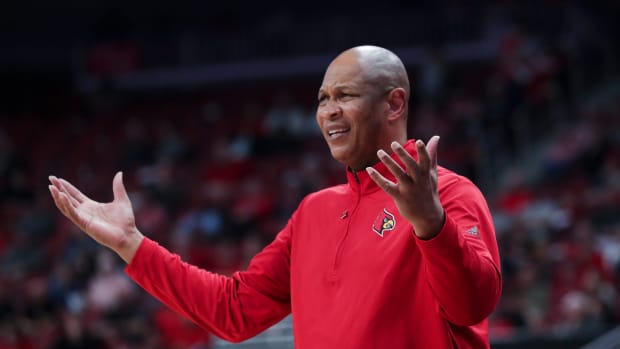Men's College Basketball Season in Review: Big Ten
The 2020–21 men’s college basketball season is in the books, but it’s not too late to look back on the year that was. We’re going conference by conference within the high-major leagues to examine what went right—and what went wrong—along with a brief look ahead to 2021–22. We’ve done the ACC, Big 12 and Big East. Next is the Big Ten.
Most important thing we learned: Depth can be a fickle thing
Let’s get the elephant in the room out of the way off the bat: After being lauded all season for its top-to-bottom high quality, the Big Ten was a big bust in the men’s postseason, with nearly all of its nine NCAA tournament teams flaming out in the first weekend. Only top-seeded Michigan went further before eventually succumbing to UCLA in the Elite Eight (sans Isaiah Livers). This came despite the fact that it had five top-four seeds overall, including four top-two seeds.
So what happened? Maybe it was bad luck in a small sample size; or maybe the conference was never as good as it seemed, especially in a year that featured a shortened nonconference slate. Or maybe there was something else at play. Did the Big Ten’s depth mean that there was actually less separation between its top, middle and bottom tiers? It’s tempting to look at the Big 12 and see that while the league sent seven teams dancing and also saw only one reach the Sweet 16, that one (national champion Baylor) won the whole thing and spent the NCAA tournament largely in cruise control.
Both conferences were lauded for their competitiveness all year, but despite the Bears’ dip in performance as they shook off the rust from a COVID-19 pause, there was never any doubt who the Big 12’s best team was. In the Big Ten? You couldn’t always say the same, fan base claims notwithstanding. Sometimes that’s a good omen and sometimes it’s a bad one; for the Big Ten in the 2021 tournament, it turned out to be the latter.
Best game: Michigan 92, Ohio State 87 (Feb. 21)
These two teams were on an absolute heater for this Sunday-afternoon showcase in Columbus. The rivals put on a stunning offensive display and shot virtually identical marks from the field (53%), with Ohio State canning 50% of its 22 three-point attempts and Michigan connecting on 47.8% of its 23. Duane Washington Jr. poured in 30 points for the Buckeyes, and E.J. Liddell added 23. The Wolverines, meanwhile, had five players in double figures, led by Dickinson’s 22. The teams traded blows all day until Michigan finally got some separation in the closing three minutes to earn a hard-fought victory.
Best player: Luka Garza, Iowa
Garza entered the season as the preseason National Player of the Year favorite and essentially led the award wire-to-wire, culminating in the Wooden and Naismith men’s awards. While the Hawkeyes as a team fell short of their biggest goals this season, Garza did all he could to cap off a superb career in Iowa City, one that included back-to-back seasons of NCAA dominance. As a senior, the big man improved to be a 44% shooter behind the arc en route to averaging a career-high 24.1 points and adding 8.7 rebounds.
Best coach: Juwan Howard, Michigan
Year 2 of the Howard era in Ann Arbor went swimmingly, with the Wolverines jumping out to an 11–0 start and reaching a peak of 18–1 amid a year when they won the Big Ten regular-season title and were a No. 1 seed in the NCAA tourney. Howard assembled an ideal modern roster, mixing returning veterans (Isaiah Livers, Eli Brooks), his own recruits (Franz Wagner, Hunter Dickinson) and capable transfers (Mike Smith, Chaundee Brown Jr.), and got them all to mesh within an offense where six different players averaged at least 8.0 points. Were it not for a poorly timed injury to Livers, Howard figured to stand a real chance at the rare feat of a coach winning it all in their first NCAA tournament.
Best newcomer: Hunter Dickinson, Michigan
One of the key questions surrounding the Wolverines back in the preseason was the center position: How much would they get out of Dickinson, a 7' 1" freshman who was a top-50 recruit in 2020? Quite a lot, it turned out. Dickinson scored double figures in 11 straight games to open his college career, immediately becoming a go-to guy in the offense who could command the paint on both ends. While he hit some lulls over the course of the season, as freshmen are wont to do, his presence was a revelation for Michigan and one of the reasons Howard’s team gelled so quickly. Dickinson finished the season ranked eighth in KenPom’s national Player of the Year rating, the second-highest freshman behind only USC’s Evan Mobley.
Biggest surprise: Purdue
We’ve covered Michigan at length already, so let’s give some love to the Boilermakers. Picked to finish ninth in the preseason media poll, Matt Painter guided his young team to an impressive 13–6 conference record, fourth-place finish and No. 4 seed in the NCAA tournament. Star big man Trevion Williams did his thing, but it was the Boilers’ supporting cast that enabled them to overachieve. Freshman Jaden Ivey showed flashes of future stardom, and 7' 4" Zach Edey looked nothing like the nation’s No. 441 ranked recruit while quickly establishing himself as a key reserve. If Williams returns for his senior season, this group could contend for not just the Big Ten title, but the national one as well—and even if he doesn’t, it should be still pretty good.
Biggest disappointment: Illinois’s loss to Loyola Chicago
The Fighting Illini entered the NCAA tournament riding as high as anyone, having won 14 of their last 15 games. They were two and a half weeks removed from destroying Michigan despite the absence of star Ayo Dosunmu, and just days removed from winning the Big Ten tournament. They were a popular pick to reach the national title game, and some even thought they could win it all. So “disappointing” doesn’t even begin to sum up Illinois’s second-round exit to Loyola Chicago in a game that it never once led. It’s not that the Ramblers weren’t a quality opponent—they certainly were, and were clearly underseeded—but the Illini program and its fans had waited a long time for its return to prominence, and it didn’t even survive the first weekend. The defeat ended up epitomizing the Big Ten’s Big Dance blunder.
Outlook for 2021–22
The Big Ten will look pretty different next season—with big-time stars like Garza and Dosunmu gone, teams like Illinois and Iowa will take a step back—but it should once again boast a few national title contenders and a good deal of depth. Michigan figures to lose multiple key starters, but Eli Brooks will return (and, very possibly, Dickinson) and Howard will bring in SI All-American’s No. 1 ranked recruiting class. Purdue is waiting on the NBA decision of Williams, who would cement it as a national contender, while Ohio State is also set to bring back the bulk of its core. Mark Turgeon has hit the transfer portal hard, and the Terrapins will be right in the mix pending the NBA decisions of Aaron Wiggins and Eric Ayala. And don’t forget teams like the Fighting Illini (especially if Kofi Cockburn returns), Hawkeyes and Wisconsin, or a Michigan State program that’s in a good position to bounce back after the arrival of SI’s No. 11 recruiting class.
More College Basketball Coverage:
• Women's College Basketball Isn't Turning Back
• SI's Way-Too-Early Men's Top 25 for 2021–22
• The Many Disparities Between Men's & Women's College Hoops
• Holmgren Commit Marks a Gonzaga Inflection Point

